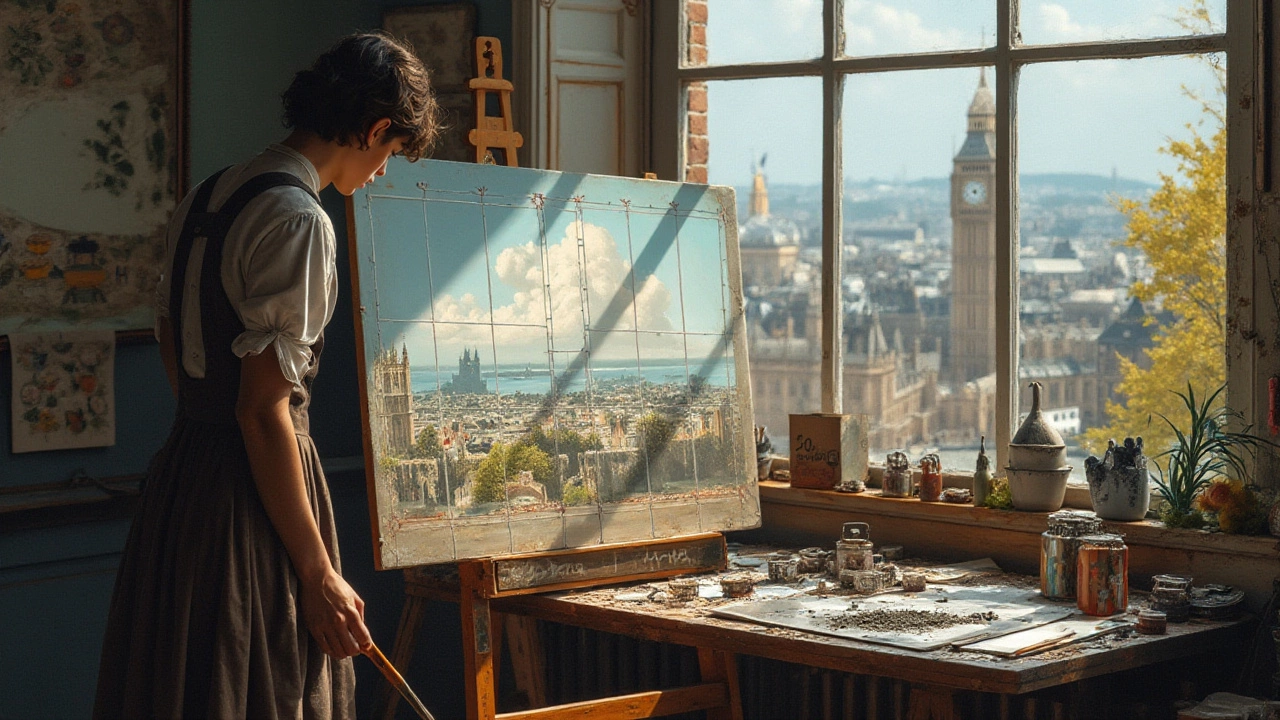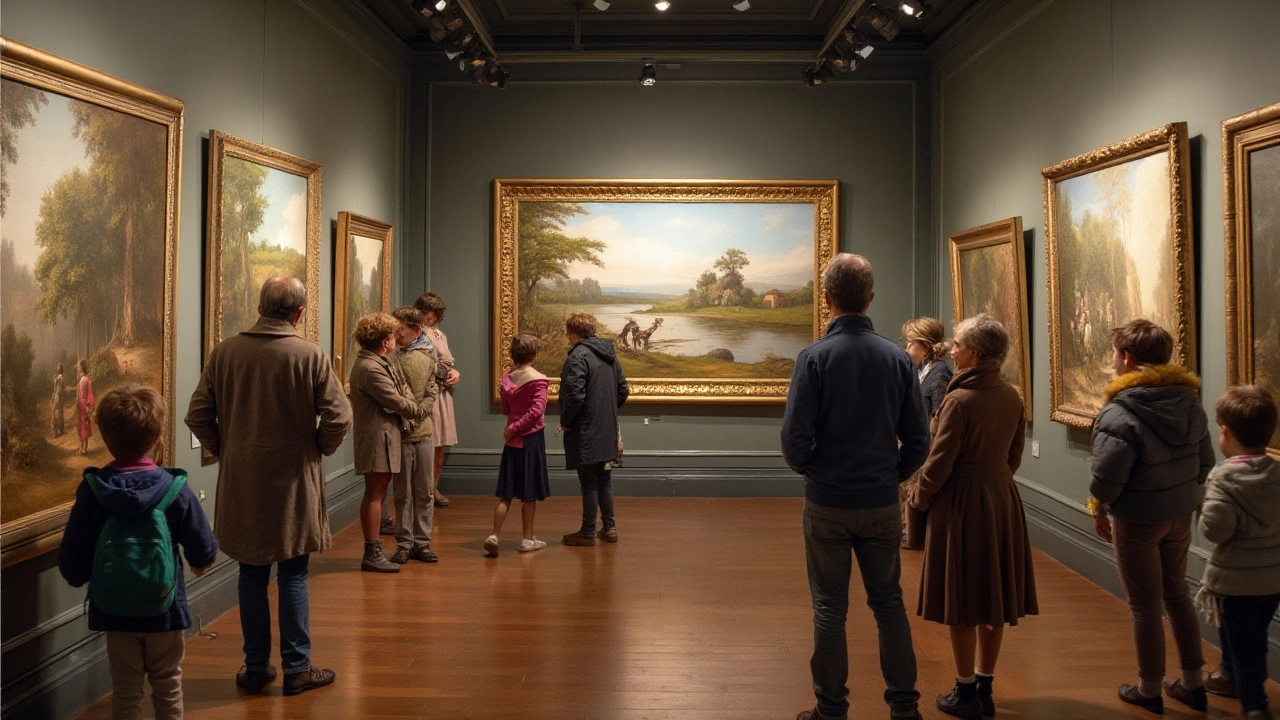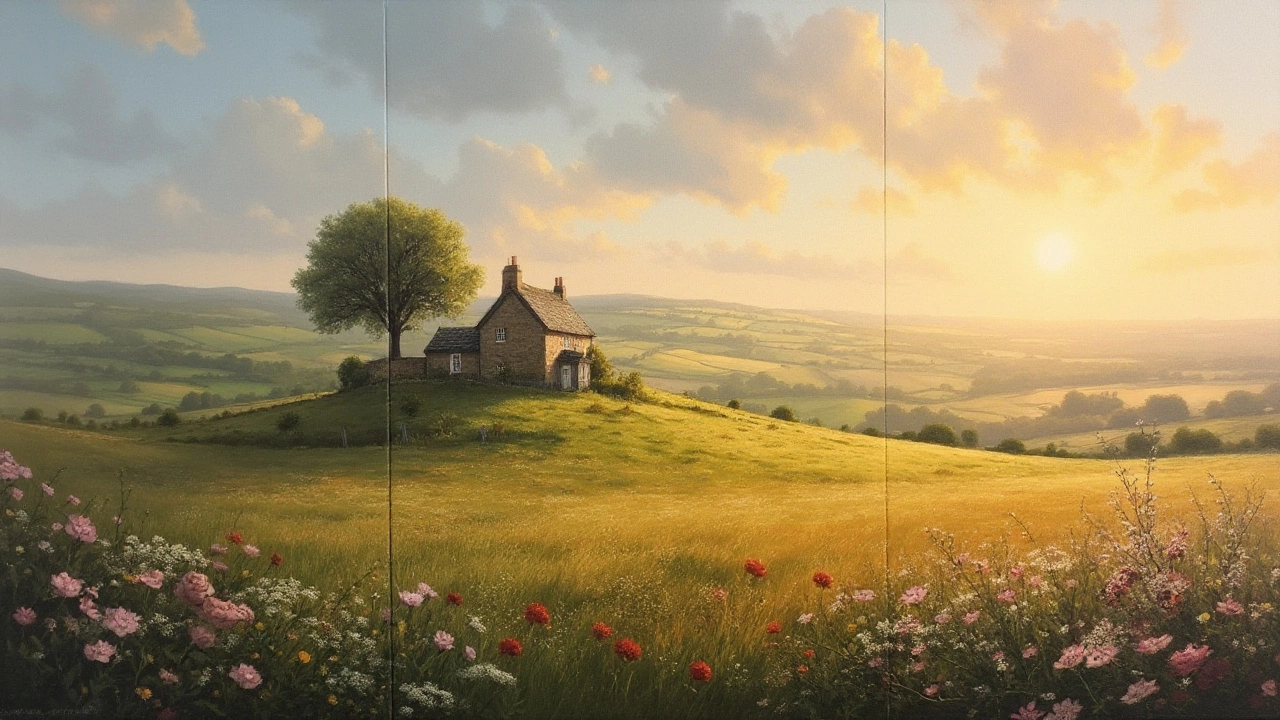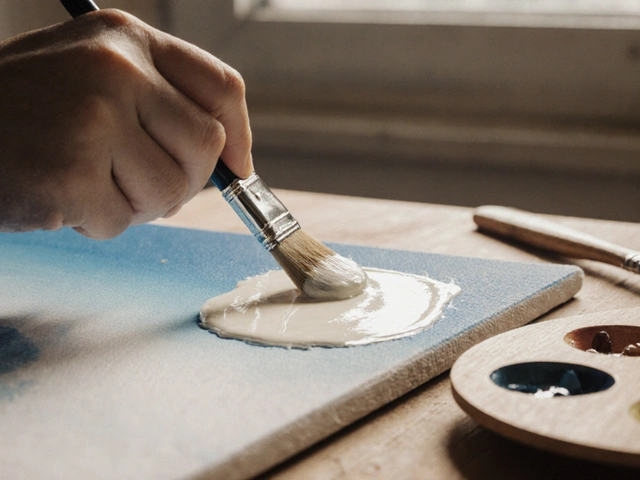In the realm of art, especially landscape painting, the rule of thirds stands as a beacon for creating balanced and harmonious compositions. Imagine your canvas divided into a grid of nine, where the intersection of lines indicates points of interest. This method, while rooted in photography, has been guiding artists for centuries in their quest to direct the viewer’s eye intuitively across their work.
By following this timeless guide, painters can breathe life into their landscapes, captivating the observer’s gaze. The right placement of elements along these lines not only balances the composition but also adds depth and focus, ensuring the story told by the painting resonates more vividly. Undertaking this approach might appear straightforward, yet its impact is profound, attracting both the novice and the seasoned artist in its simplicity.
- Understanding the Rule of Thirds
- Origins and History
- Application in Landscape Painting
- Breaking the Rule Creatively
- Tips for Artists
Understanding the Rule of Thirds
Imagine gazing upon a sprawling landscape, perhaps an expanse of meandering rivers and towering mountains under a crisp azure sky. In this view, your eye instinctively seeks a balance across the scene. Enter the rule of thirds, a guiding principle in art and photography, which divides an image into nine equal segments with two equally spaced horizontal lines and two vertical lines. Where these lines intersect, known as focal points, are positions of greatest interest. Leveraging these points helps artists capture natural harmony and tension, crafting works that hold the viewer's gaze. This simple grid becomes a powerful tool, offering both a structure and a springboard for creativity.
The concept, although simple in its grid design, brings depth and character to a composition. It's rooted in the golden mean, an aesthetic found in nature, architecture, and throughout art history. By shifting elements off-center, the landscape painting comes alive, often evoking emotion and narrative. Artists use these intersection points to place interesting subjects, whether it be a lone tree in a field or a glimmering reflection in a lake. The rule of thirds nudges the viewer to explore the painting, moving from one focus area to another, creating a dynamic journey rather than a static glance.
Within the realm of perception, the rule's efficacy is unparalleled. It guides the placement of the horizon line in a landscape, determining if the sky or the land should dominate the scene. By aligning the horizon with one of the horizontal thirds, artists lend weight to the segment they wish to highlight. This age-old trick can transform the narrative of the artwork, imbuing it with a distinctive voice. For example, a higher horizon emphasizes the earth and structures below, while a lower placement elevates the heavens and celestial drama.
The rule also encourages asymmetric balance. Unlike the stiff, absolute symmetry seen in straight dividing lines, the varied distances in thirds allow for a more organic scene that resonates with the unpredictability of nature. Imagine splitting tension between a foreground element, a middle-ground interest, and a background horizon; the third division naturally aids in this task. This approach enlivens the painting and leaves room for the subtle interplay of visual weights across the canvas.
A small but fascinating application involves the contrast by juxtaposition. When used cleverly, objects placed at intersection points can contrast with one another, creating narrative elements. The bright yellows of autumn leaves against the cool blues of a river, or a solitary red barn against a vast field of gold, achieve a visual dialogue that speaks to those who engage with the scene. This dialogue enriches the viewer's experience, immersing them deeper into the story that the painting whispers.
| Benefits of Rule of Thirds | Example |
|---|---|
| Achieves natural balance | Horizon placed on the upper third enhances ground details |
| Directs the viewer's eye | A tree on an intersection point becomes a focal subject |
While these guidelines set a foundation in art, creativity itself knows no bounds. Artists often choose to bend or outright break the rule of thirds to communicate their message powerfully. When exploring how best to employ this tool in your own landscape painting, think beyond the literal grid—it’s as much an invitation to exploration as it is a rule. The alchemy of emotion, concept, and technique on a canvas is where true artistry lives, and the rule of thirds can be both a trusty guide and a stepping stone to new possibilities.
Origins and History
The rule of thirds has its philosophical roots grounded in the ancient principles of balance and harmony, ideas that have pervaded human endeavor across disciplines like art, mathematics, and even architecture. Though the concept as we recognize it today was refined alongside the rise of photography in the 19th century, its application stretches much further back into history. Renaissance artists, for instance, sought a similar balance by employing mathematical grid systems pivotal in composing their masterpieces. This instinct to evenly arrange forms and space in a manner that is appealing to the eye has been part of art's evolution ever since humankind first began to paint and draw.
The term 'rule of thirds' itself became codified during the 18th century with the artist and theorist John Thomas Smith, who introduced it in his book, "Remarks on Rural Scenery" published in 1797. Smith, observing natural aesthetics, proposed dividing landscapes into one-third and two-thirds, much akin to the ideals put into practice in the positioning of landscape elements and horizon lines in paintings and photographs. The underlying philosophy was to enhance visual tension and interest by positioning key elements off-center, thus deviating from the conventional central focus to create a dynamic asymmetry.
In contemporary practice, the rule of thirds is a cornerstone in art education, as it provides a simple yet powerful tool for aspiring artists to achieve balance intuitively in their compositions. Its versatility spans across forms of visual art beyond just landscape painting. Today, seasoned artists and designers alike apply this rule in various ways, even creatively defying it to elevate their artwork’s narrative. As celebrated photographer Henri Cartier-Bresson once implied, rules are integral to learn so they can later be broken. Indeed, understanding the rule of thirds gives artists a fundamental compositional framework, allowing them to explore and push boundaries.

Application in Landscape Painting
The application of the rule of thirds within landscape painting is akin to revealing a secret code that underpins some of the most captivating works in art history. Artists utilize this principle to strategically direct where a viewer's eyes will naturally go, enhancing the storytelling aspect of the landscape depicted. The canvas, broken into a grid, usually two horizontal and two vertical lines spaced evenly apart, forms focal points at each intersection. By placing key components such as a lone tree, a building, or a horizon at these intersections, artists can elicit interest without crowding the canvas. This technique fosters a natural flow, encouraging viewers to explore the entire painting with ease rather than getting stuck in less significant areas.
Historically, many renowned landscape artists have employed this rule, knowingly or unknowingly. Claude Monet, for example, often aligned the horizon of his serene water lilies series with one of these lines, allowing the play of light and reflection to dominate the remaining canvas. The impact is such that it creates an expansive yet calm vista, drawing viewers into the scene itself. Similarly, in seascapes by J.M.W. Turner, the sky is often granted two-thirds of the space. This was not merely an artistic whim but a calculated decision to enhance the drama and mood, forging an emotional connection with the viewer. Interestingly, Turner once stated, "Painting is a natural process; let it flow"—a sentiment echoing this compositional tool.
The practical application of the rule goes beyond aesthetics; it serves as guidance for artists, particularly those newly venturing into the world of landscape painting. Many beginners may find themselves overwhelmed by the vastness of a scene. By employing this technique, artists can simplify complex environments, focusing on three main categorical areas: foreground, middle ground, and background, each correlating to the grid zones. This not only ensures a balanced visual but adds depth and dimension. Keeping these spatial divisions in mind, artists can assert control over their compositions, yet simultaneously invite chance and spontaneity into their work.
For those who wish to practice this, the process can be as intuitive as it is technical. Start by imagining or lightly sketching the grid onto your canvas. Decide what element of your landscape should dominate and position it accordingly. Whether it's the peak of a mountain, the inviting path through a forest, or a boat gently cutting through the ocean, placing these at the intersections helps solidify their importance. While it may sound rigid, countless artists find liberation in this structure, allowing for greater experimentation within constraints. Indeed, the rule of thirds ultimately becomes a tool, a gentle guide that lets creativity flourish.
The magic of this rule lies in its adaptability. In its simplicity, it presents a framework, yet it does not stifle creativity. It's certainly not a one-size-fits-all solution, as some landscapes naturally defy conformity, but its purpose is not to prescribe absolute precision. It's about finding that balance, that harmony in your work that stirs something within both artist and observer alike. Artists are free to push boundaries beyond the constraints of the grid as they gain confidence in their work, often discovering that it takes just a minor shift along the gridlines to transform an ordinary scene into something extraordinary.
Breaking the Rule Creatively
Creative expression thrives on the ability to bend and break rules, and the rule of thirds in landscape art is no exception. For many artists, stepping outside the boundaries of this established guideline opens up a world of unexplored composition landscapes. For instance, consider how the drawn lines of the grid often encourage artists to place elements in focal intersections. Yet, drawing attention away from these points can reshape the emotional narrative conveyed by their work. Artists might choose to place their central figures at the very edge or corner of their canvas, subverting expectations and evoking an unexpected sense of dynamism.
Take, for example, the renowned painter J.M.W. Turner, whose knack for atmospheric effects often led him to forsake the typical conventions of composition. His work sometimes appears to abandon conventional balance. By placing intense focal points off-grid, Turner managed to dramatize the raw force of nature, setting a precedent for what can be achieved when one dares to defy. He once remarked,
"It's not enough to see the work, it must be felt, unraveled, and lived."Such willingness to break rules doesn't diminish the effectiveness of the rule of thirds, but rather offers it as a starting canvas upon which artistic rebellion can sketch its wild, enticing patterns.
Another important aspect of breaking the rule creatively involves integrating new elements such as abstract forms or innovative color palettes that seemingly drift from established composition standards. Many modern artists incorporate surrealism, allowing unrealistic elements to float through more traditional landscapes. This idea embraces a deeper narrative, where landscapes become portals to alternative realities, urging viewers to embark on a journey of imagination. While classic landscapes favor predictable harmony within the grid, these deviations invite a sense of exploration and personal engagement.
To explore breaking the rule creatively, one could start by experimenting with lights and shadows in unconventional ways. Imagine a painting where the light source is purposefully misplaced, giving shadows exaggerated prominence. This overturns typical tonal balance and captivates the viewer with its mysterious ambiance. Lighting, when unruly and surprising, can transform what is often predictable into something intriguingly provocative. Artists might also utilize an unexpected frame within a frame technique, capturing a subject both within and outside the focal area, challenging the observer's perception with overlapping realities.
For those eager to test the boundaries of composition, using mixed media could be an exciting avenue to explore. Artists might combine traditional painting with digital elements or incorporate physical textures that stand apart from the painted surface. These techniques add tangible depth, inviting viewers to not just see but physically engage with the piece. Such multidimensional creations effectively illustrate how artworks can transcend the typical two-dimensional confines plotted by the rule of thirds.
In summary, while the rule of thirds remains a valuable guide in landscape painting, the true spirit of art lies in its ability to defy standard practices compellingly. Whether through repositioning subjects, employing atypical lighting, or harnessing the power of mixed media, artists can create lasting works that both honor tradition and forge novel paths. Remember, rules in art exist as tools, not chains, and knowing when to set them aside is one of the most powerful secrets every artist should embrace.

Tips for Artists
Creating stunning landscapes isn’t just about following the rule of thirds as if it were a set-in-stone guideline. Think of it as a trusty compass, ready to aid you in your creative journey. When wielding this tool in your artistic process, there are several hints and tricks to refine your composition. To effectively apply the rule, begin by identifying the focal points of your scene—the clusters of trees, a striking mountain peak, or the horizon line. Imagine aligning these elements along your grid, ensuring the main subject doesn’t merely occupy the center, but rather captures a viewer’s interest by playing along the intersections. Precision in this balance can greatly enhance your painting’s allure.
Now, while the rule of thirds provides a solid structure, it shouldn't become a constraint. Take the liberty to deviate and explore. Many renowned artists, including the likes of Claude Monet, have occasionally redefined their compositions by favoring innovative symmetry or deliberately off-centered placements. Such deviations can bring forth spontaneity, adding an unanticipated dynamic to your work. An engaging landscape often emerges when it subverts expectations, challenging viewers to see the familiar in new ways. So play with different arrangements and learn how shifting the horizon line can dramatically alter your portrayed emotion.
Experimentation is key, and embracing a playful mindset can often lead to masterpieces. Utilize tools such as sketch overlays or digital software to draft multiple compositions. As Theodor von Holst once remarked,
"Art is limited by the imagination of those who create it."This freedom allows artists to transform static landscapes into lively narratives through composition. Indeed, whether painting sweeping vistas or intimate garden scenes, contemplating these variations can deepen your understanding and appreciation of how balance and motion affect each piece.
To further refine your skills, consider practicing with photography as an intermediary step. Snapping scenes with the grid enabled provides a firsthand look at natural composition—how nature's own chaos often aligns with the rule of thirds. Studying these photographs offers insights without the pressure of producing a final artwork. Additionally, attending local art exhibitions in cities like Vancouver can expose you to diverse techniques, offering new perspectives and methodologies that resonate with your personal artistic style.
Don't forget that a measure of success comes from the blending of technique with intuitive creativity. And for those moments when the dots don’t seem to connect, joining an artist forum or attending workshops can provide fresh ideas and encourage your growth. Remember, every great artist once started out experimenting with these foundational strategies. Whether you're just beginning your artistic journey or honing established skills, embracing these painting tips can pave the way for creating compelling landscapes that draw viewers in and leave a lasting impression.


